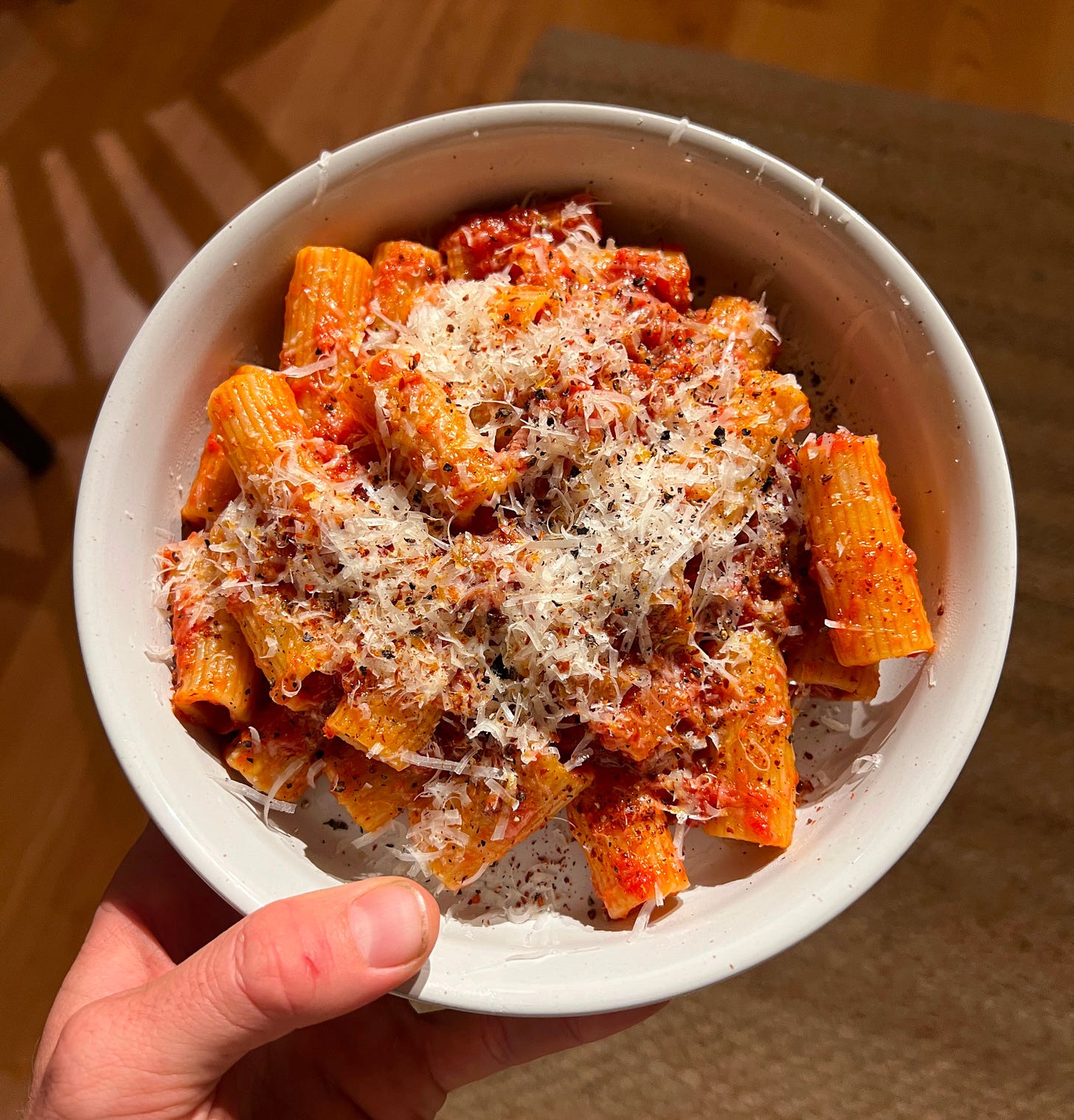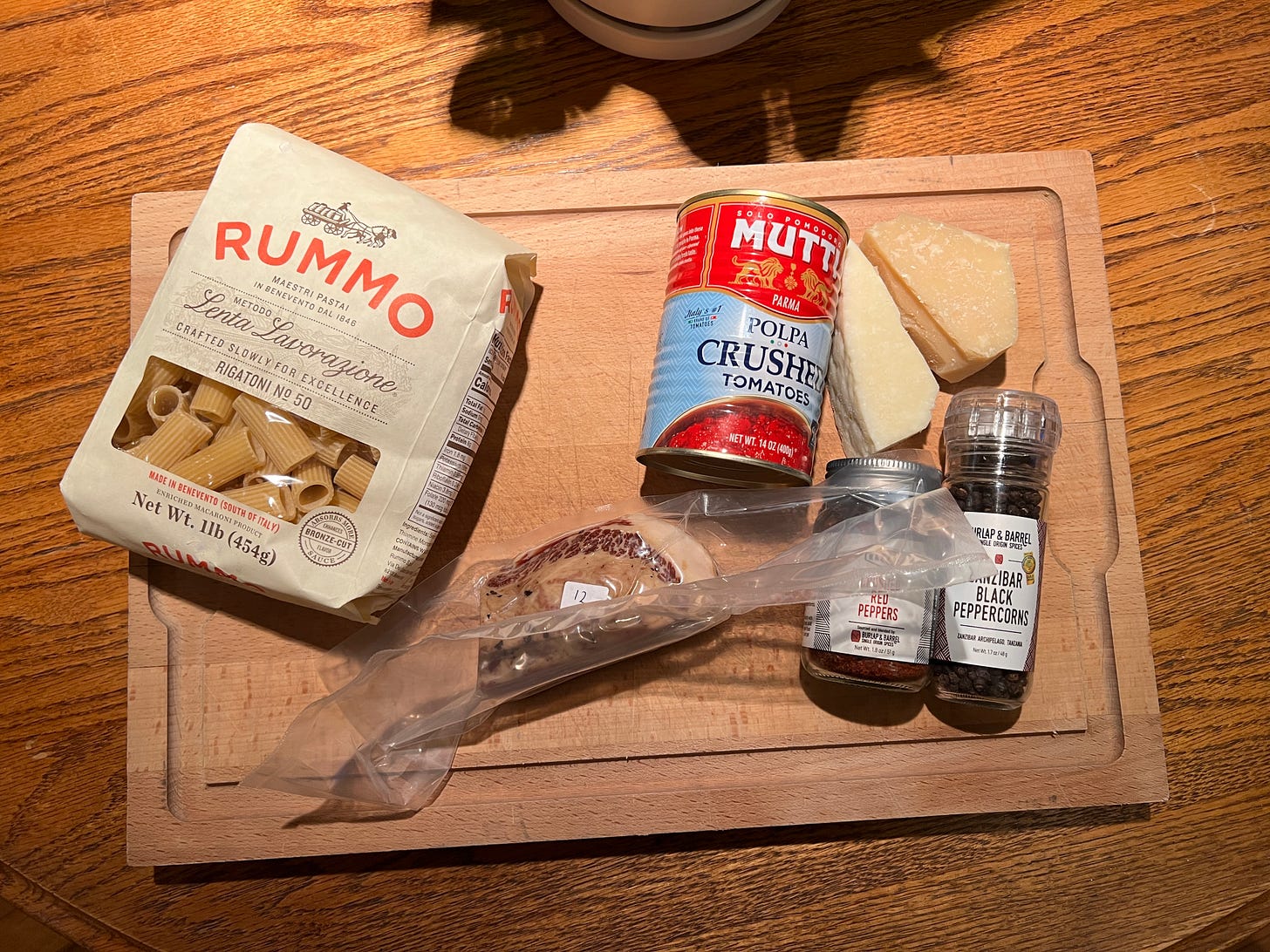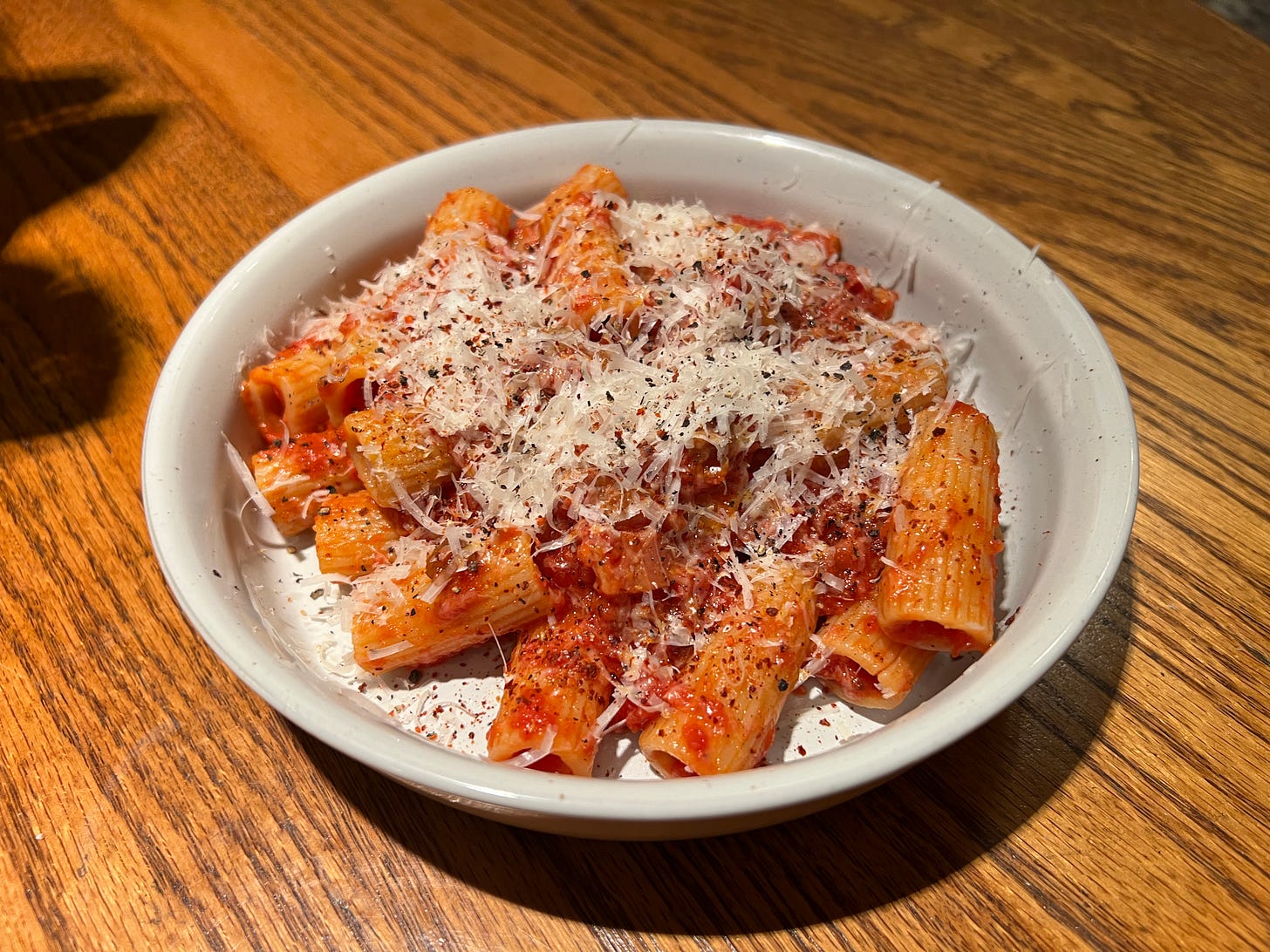Pasta all’Amatriciana
A traditional Roman classic typically refers to dishes like Pasta Carbonara, Cacio e Pepe, or Saltimbocca. These dishes are characterized by simple, high-quality ingredients and time-honored techniques.
A Traditional Roman Classic

Hey, everyone!
Today I’m sharing one of the recipes that’s included in 80/20 Cooking, a guide to the fundamentals of cooking that I recently released. It includes 12 lessons covering foundational skills, plus 18 recipes that are designed to put those skills into practice.
My goal with the included recipes was to make them lessons in and of themselves, focusing on core techniques that apply beyond that specific dish.
This is one such example. I love this pasta dish; it’s one of the four traditional pastas of Rome, and it’s a beautiful way to experience the Italian ethos of simplicity with a focus on a few really high-quality ingredients. But I also love it because it helps you to master a lot of the core skills that apply to any pasta dish— how to properly salt your pasta water, how to cook dried pasta to the perfect al dente, how to build a sauce and bring it together with starchy pasta water, and a bunch more.
Let me know what you think! If you want to check out 80/20 Cooking, you can learn more at the website, or purchase with this link (use the code SUBSTACK for 20% off).
Enjoy!
Myles
Notes
This dish is a great introduction to the core techniques of pasta cooking. There are a few things you need to get right to successfully cook pasta— especially dried pasta.
- Use a large, heavy-bottomed pot (I like to use a saucier, stock pot, or Dutch oven). You want a large volume of water so that it can quickly return to a boil and remain there after the pasta is added.
- Salt the pasta water heavily. Pasta water seasons the pasta as it cooks, and you need a lot of salt to allow this to happen. In Italy they like to say that the pasta should taste like ocean water— this might be slight overkill, but it should be very salty. Taste the water after you salt it to make sure it tastes quite salty.
- Allow the water to return to a rolling boil after you add the salt, and only then add your pasta. You want it to return to a boil quickly afterwards. Using a large volume of water helps here, or you can briefly cover the pot to speed up this process. Just make sure you keep an eye on it so it doesn’t boil over and extinguish your stove’s flame.
- Stir the pasta right after you put it into the water, and throughout the cooking process, so that it doesn’t stick together or stick to the bottom of the pot.
- Don’t add olive oil to the pasta water. You’ll occasionally see this suggested but it’s wrong and counter-productive. It will prevent the sauce from adhering to the noodles in the final step.
- Cook the pasta until it’s al dente, meaning it has a slight bite to it. Italians cook pasta slightly less time than we do in America, but theirs is the proper way. Pasta with a slight bite to it has the best taste and texture, and there are few things worse than overcooked, gummy pasta. The correct cook time is not what’s listed on the package— it’s simply when the pasta tastes and feels al dente.
- You want to reserve some of the pasta water to incorporate into your sauce. This helps to season the sauce, and the starch in the pasta water helps to thicken it.
- The final step of the cooking process is to toss together the pasta, pasta water, and sauce. This process creates the a thick sauce that coats the noodles. You can also add shaved hard cheeses in at this point— tossing them with the pasta will create an even thicker, creamier sauce.
We’ll cover all of these with step-by-step photos below, but know that all of these core techniques apply any time you’re making pasta!
Let’s dive in!
Ingredients

- 12 ounces dried pasta (I like this with rigatoni, penne, or bucatini). Seggiano is my personal favorite dried pasta brand.
- 1/4-1/3 pound guanciale or pancetta (cut into small cubes)
- 1 14oz can whole peeled crushed tomatoes (or whole peeled tomatoes that you crush yourself)
- 1/4 cup each shaved Parmesan and Pecorino, plus more for finishing
- chile flakes
- black peppercorn
- salt
Note: This should make about 3-4 servings. I use a bit more than 1/4 pound of guanciale, but you can use slightly more if you’d like for a richer sauce. Start with 14oz of tomato, but feel free to add a bit more if need be— just don’t drown it in tomato. Finally, know that a lot of the ingredients we’ll add (guanciale, parmesan, pecorino, pasta water) are quite salty, so you may not need to add much additional salt. TASTE as you go!
Process
Start by filling a pot with water and bringing it to a boil. Once the water is boiling, add in a very generous handful of salt. Don’t be shy— see the video below.
Taste the pasta water with a spoon. It should be quite salty.
Place the cubed guanciale into a cold stainless steel pan and turn the heat to low. Cook the guanciale, stirring occasionally and allowing the fat to slowly render out.
Guanciale and pancetta are both quite fatty, and starting the pan cold and allowing it to slowly heat up will cause the fat to slowly melt— this is a technique known as rendering. Most of the time, you won’t even need any additional oil in this recipe because the guanciale will produce so much fat.
Cook until the guanciale is mostly cooked through and just starting to crisp up and has released a lot of fat.
Pour in your crushed tomatoes and add in a couple of tsp of chile flakes and a few twists of fresh-cracked black pepper. Give everything a stir.
Allow it to cook for a minute or so, and then taste it for salt. Guanciale is quite salty, and you’ll be adding more salty ingredients (pasta water and hard cheeses), so don’t add too much at this point.
Allow the sauce to gently simmer over low to medium-low heat. It will slowly reduce a bit.
Once the pasta water is at a rolling boil, add in your pasta and stir to ensure that the pasta doesn’t stick together.
Allow the water to return to a boil. You can cover the pot briefly to help speed up this process, but make sure it doesn’t boil over and extinguish your flame.
Continue to stir the pasta as it cooks.
You can use the cook time listed on the pasta package as a general suggested cook time. But you must check and taste the pasta throughout.
With dried pasta, you want to go for a final feel that’s called al dente, which translates roughly as “toothsome.” It should be cooked through but still slightly firm to the bite. You can check by cutting a piece of pasta open— you’ll see a white lining inside if the pasta isn’t yet cooked through. That should be mostly gone by the time it’s al dente, but you should really base it on the mouthfeel. Al dente pasta may still have a very thin white line that’s just barely visible.
Great dried pasta should have slightly more chew than you might be used to. It will continue cooking in the sauce, and you definitely don’t want overcooked, gummy pasta.
Once the pasta is close to being done, take about a quarter to a half cup of the pasta water and add that to the sauce. This step is especially important— the starchy, salty pasta water helps to season the sauce and thicken it. Give it a stir and allow it to incorporate. Set aside another quarter cup of pasta water in case you need to add more.
Taste the sauce and adjust as needed with salt.
As soon as the pasta is done, drain it in a strainer and add then it to the sauce immediately.
Toss the pasta in the sauce to cover it.
Then add a quarter cup each of shaved Parmesan and Pecorino to the pasta, along with some more chile flakes and black pepper, and toss everything to combine.
If you want to thin out the sauce a bit more, you can add in a bit more pasta water and continue to toss.
Spoon the pasta into bowls, add a bit more cheese, a twist of fresh black pepper, and some chile flakes.
Enjoy immediately.
